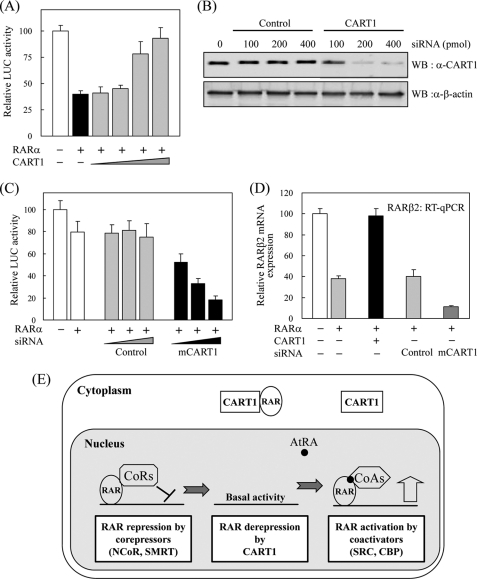FIGURE 7.
Effect of CART1 on transcriptional activity of RAR. A, shown is the effect of CART1 on transcriptional activity of RAR in the absence of AtRA. NIH3T3 cells were cotransfected with RARα (0.2 μg) and increasing amounts (0.1, 0.2, 0.4, 0.8 μg) of FLAG-CART1 together with the RARE-tk-luciferase reporter. Each bar represents the percent of mock treatment. The relative luciferase (Luc) activity was determined by luciferase assay after normalizing to the observed β-galactosidase activity. Data are the average of three independent experiments (mean ± S.D.). B, shown is the effect of siRNA on CART1 expression. After transfection into TM4 cells, using the amounts indicated, the expression of mouse CART1 was monitored by WB using an anti-CART1 polyclonal antibody. C, shown is the effect of CART1 knockdown on transcriptional activity of RAR. TM4 cells were cotransfected with RARα (0.2 μg) and increasing amounts of CART1 siRNA, as indicated in Fig. 7C, together with the RARE-tk-luciferase reporter. The relative luciferase activity is shown by the average of three independent experiments (mean ± S.D.). D, shown is the effect of CART1 overexpression or knockdown on the expression of endogenous RAR-regulated RARβ2 gene. Total RNA was extracted from TM4 cells transfected with control or CART1-specific siRNA (200 pmol) and subjected to real-time PCR coupled to reverse transcription. The expression levels were normalized using GAPDH as an internal standard. Relative expression (%) was defined as the variation relative to control. E, shown is a postulated model for the role of CART1 in RAR regulation. In testis cells, where CART1 is abundant, CART1 interacts with apoRAR in the cytoplasm, thus preventing its repressor function by cooperating with corepressors in the nucleus. In the presence of ligand AtRA, RAR dissociates from CART1 and moves to nucleus where it interacts with coactivators for transcriptional activation. qPCR, quantitative PCR.

